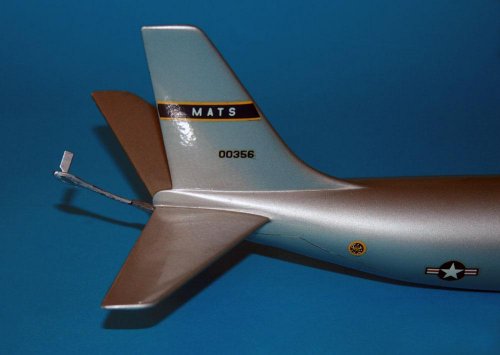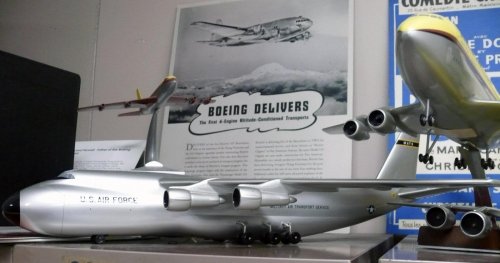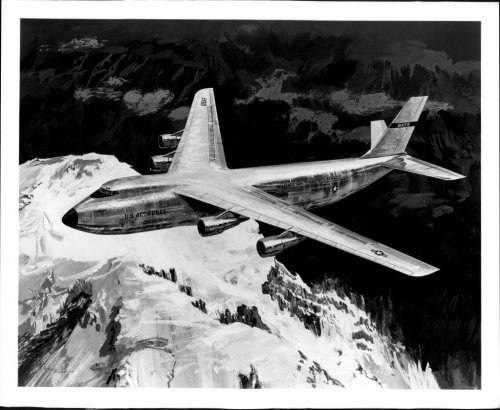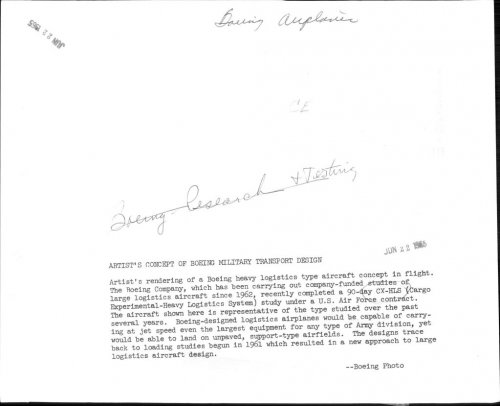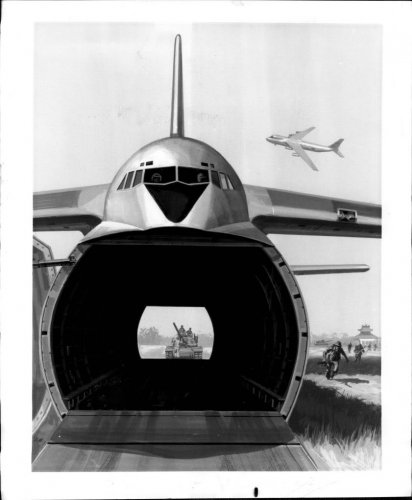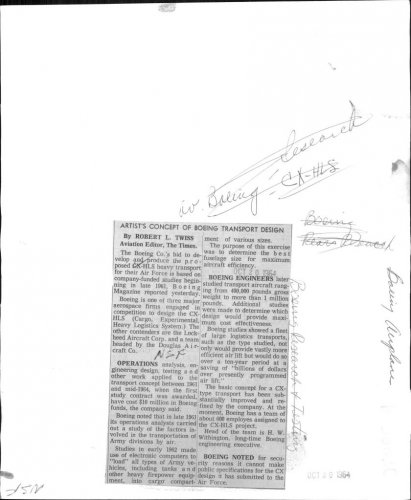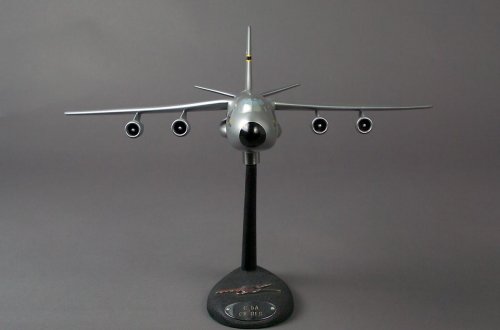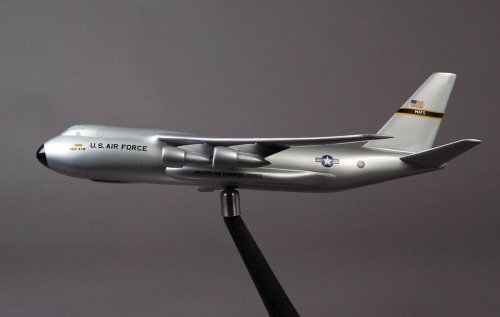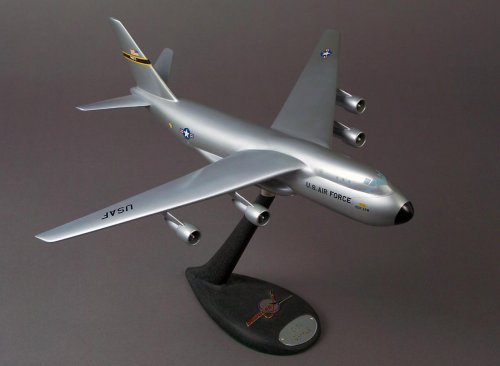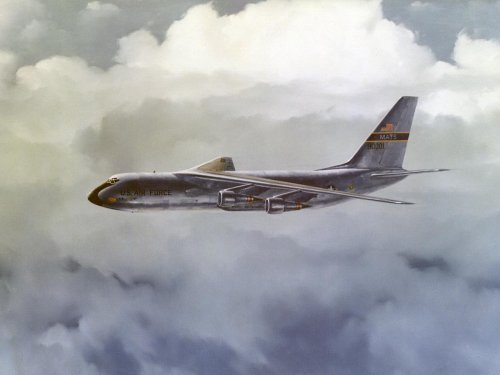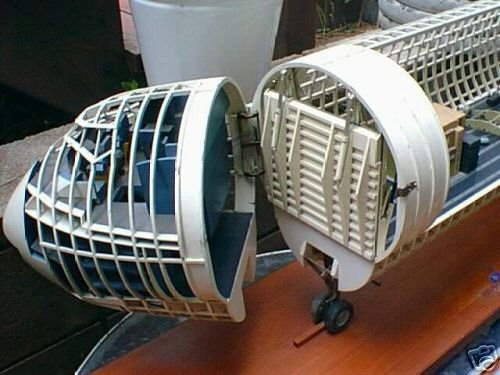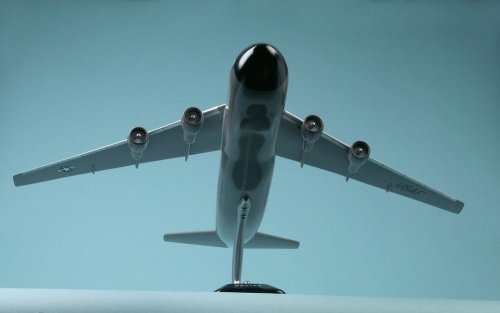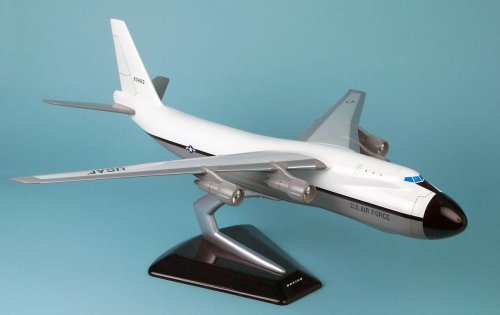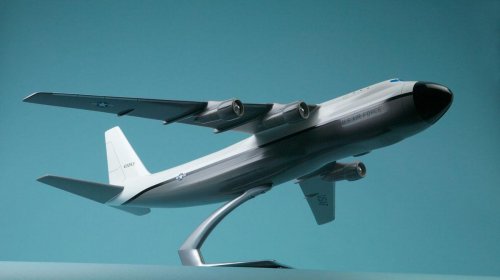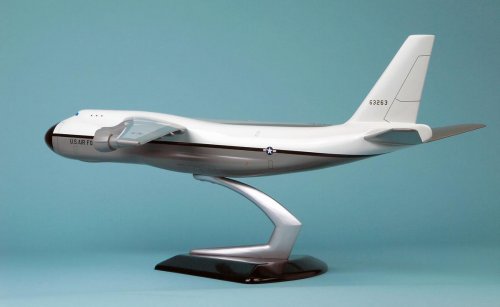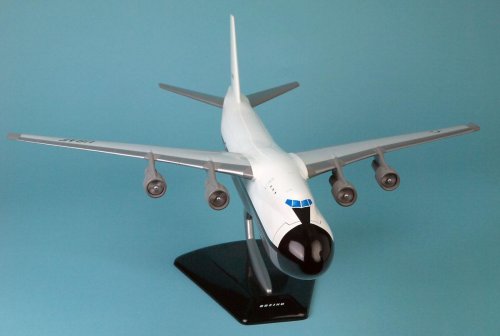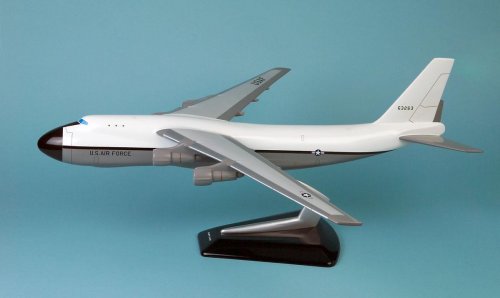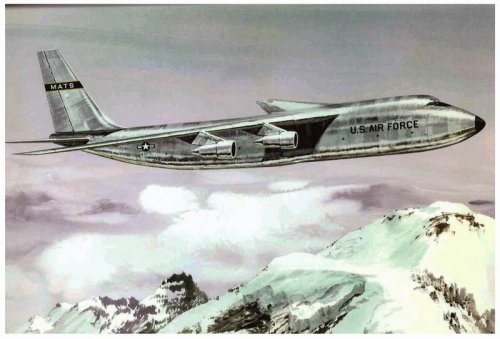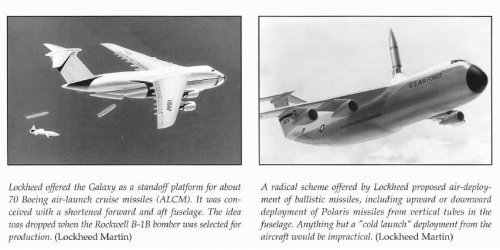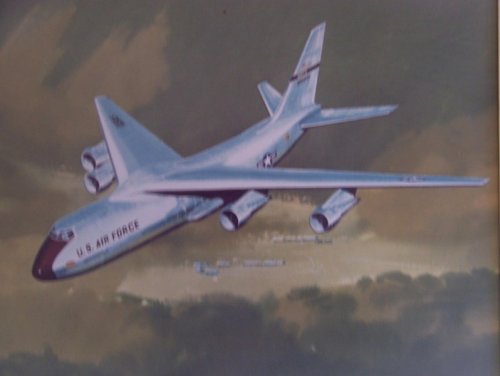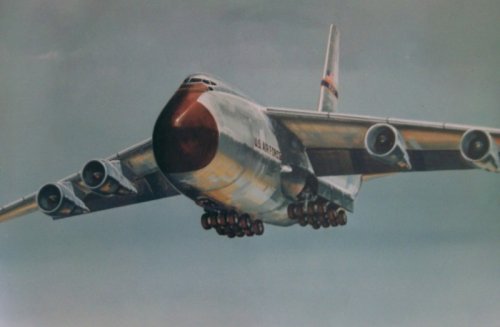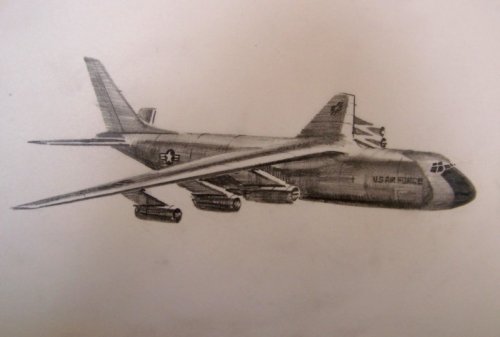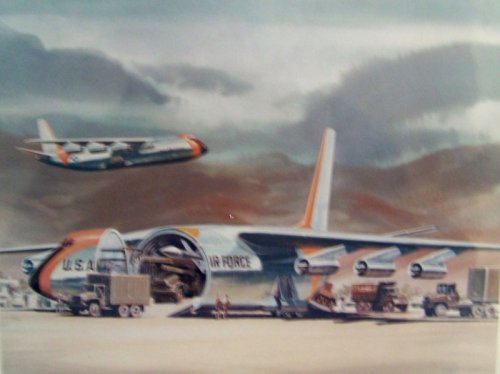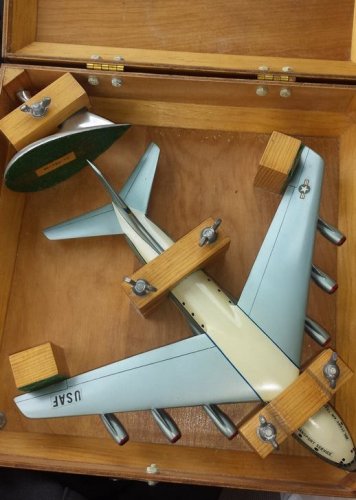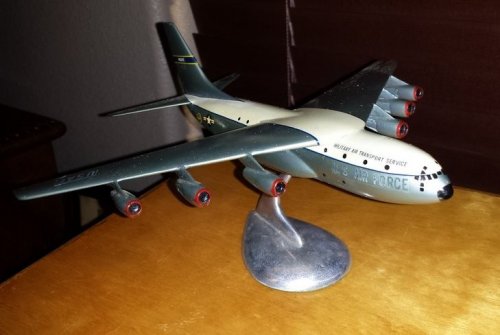You are using an out of date browser. It may not display this or other websites correctly.
You should upgrade or use an alternative browser.
You should upgrade or use an alternative browser.
CX-HLS (Cargo Experimental, Heavy Logistic Support) designs & derivatives
- Thread starter Antonio
- Start date
- Joined
- 31 May 2009
- Messages
- 1,154
- Reaction score
- 671
aim9xray said:I have no idea - but note the refueling boom on the model...
Yes, thank you. As you can see on the attached close-up, the tanker option is in addition to the rear cargo doors. I assume that, even as a tanker, this aircraft proposal still met CX-4 airlifting requirements.
Attachments
Interesting. Thank you for sharing, circle-5.
- Joined
- 31 May 2009
- Messages
- 1,154
- Reaction score
- 671
I found the drawings for the Douglas D-902/6 -- a very different airplane, despite its 6-engine configuration. The model shown in this thread is therefore, with reasonable certainty, the Douglas D-906C.
However, because the D-902/6 was proposed for the CX-4 competition (1962), there is a good chance the D-906C was actually designed for the CX-X requirement (late 1963).
I don't believe CX-X mandated four engines, as CX-HLS did in 1964 with the TF-39. Maybe somebody knows more about this.
Regardless, CX-X was a one-year, interim program, which may explain the lack of available information. Time to dust off the appropriate pile of AW&ST and dig in...
However, because the D-902/6 was proposed for the CX-4 competition (1962), there is a good chance the D-906C was actually designed for the CX-X requirement (late 1963).
I don't believe CX-X mandated four engines, as CX-HLS did in 1964 with the TF-39. Maybe somebody knows more about this.
Regardless, CX-X was a one-year, interim program, which may explain the lack of available information. Time to dust off the appropriate pile of AW&ST and dig in...
- Joined
- 25 June 2009
- Messages
- 14,751
- Reaction score
- 6,113
circle-5 said:Regardless, CX-X was a one-year, interim program, which may explain the lack of available information. Time to dust off the appropriate pile of AW&ST and dig in...
Hadn't even heard of a CX-X interim program. Thanks for digging it up!
Model of Boeing CX-HLS circa 1963-64 located in the Boeing Archives Bellevue, Washington.
Source:
http://airchive.com/html/museums/boeing-archives-bellevue-washington-usa/boeing-cx-hls-model-196364/19149
In 1963, the United States Air Force started a series of study projects on a very large strategic transport aircraft. Although the C-141 Starlifter was being introduced, they felt that a much larger and more capable aircraft was needed, especially the capability to carry outsized cargo that would not fit in any existing aircraft. These studies led to initial requirements for the CX-Heavy Logistics System (CX-HLS) in March 1964 for an aircraft with a load capacity of 180,000 pounds (81,600 kg) and a speed of Mach 0.75 (500 mph/805 km/h), and an unrefueled range of 5,000 nautical miles (9,260 km) with a payload of 115,000 pounds (52,200 kg). The payload bay had to be 17 feet (5.18 m) wide by 13.5 feet (4.11 m) high and 100 feet (30.5 m) long with access through doors at the front and rear. Featuring only four engines, the design also required new engine designs with greatly increased power and better fuel economy. On May 18, 1964, airframe proposals arrived from Boeing, Douglas, General Dynamics, Lockheed and Martin Marietta; while engine proposals were submitted by General Electric, Curtiss-Wright, and Pratt & Whitney. After a downselect, Boeing, Douglas and Lockheed were given additional study contracts for the airframe, along with General Electric and Pratt & Whitney for the engines. All three of the airframe proposals shared a number of features. As the CX-HLS needed to be able to be loaded from the front, a door had to be included where the cockpit usually was. All of the companies solved this problem by moving the cockpit to above the cargo area; Douglas had a small "pod" just forward and above the wing, Lockheed used a long "spine" running the length of the aircraft with the wing spar passing through it, while Boeing blended the two, with a longer pod that ran from just behind the nose to just behind the wing. In 1965 Lockheed's aircraft design and General Electric's engine design were selected for the new C-5 Galaxy transport, which was the largest military aircraft in the world at the time. The nose door and raised cockpit concepts would be carried over to the design of the 747. Courtesy: Wikkipedia
Source:
http://airchive.com/html/museums/boeing-archives-bellevue-washington-usa/boeing-cx-hls-model-196364/19149
Attachments
You are bidding on an original press photo from 1964 featuring Artist's Concept of Boeing Transport Design The Boeing Co's bid to develop and produce the proposed CX-HLS heavy transport for their Air Force is based on company-funded studies beginning in late 1961, Boeing Magazine reported yesterday. Boeing is one of three major aerospace firms engaged in competition to design the CX-HLS (Cargo, Experimental, Heavy Logistics System.) The other contenders are the Lockheed Aircraft Corp. and a team headed by the Douglas Aircraft Co. Operations analysis, engineering design, testing a n d other work applied to the transport concept between 1961 and mid-1964, when the first study contract was awarded, have cost $10 million in Boeing funds, the company said. Boeing noted that in late 1961 its operations analysts carried out a study of the factors involved in the transportation of Army divisions by air. Studies in early 1962 made use of electronic computers to "load" all types of Army vehicles, including tanks a n d other heavy fire1964-10-20T14:02:33+05:30go compartment of various sizes. The purpose of this exercise was to determine the best fuselage size for maximum aircraft efficiency. Boeing Engineers later studied transport aircraft ranging from 400,000 pounds gross weight to more than 1 million pounds. Additional studies were made to determine which design would provide maximum cost effectiveness. Boeing studies showed a fleet of large logistics transports, such as the type studied, not only would provide vastly more efficient air lift but would do so over a ten-year period at a saving of "billions of dollars over presently programmed air lift." The basic concept for a CX-type transport has been substantially improved and re-fined by the company. At the moment, Boeing has a team of about 600 employes assigned to the CX-HLS project. Head of the team is H. W. Withington, long-time Boeing engineering executive. . Photo is 8” x 10” in size.
URL:
http://www.ebay.com/itm/1964-Boeing-Airplanes-Sketch-Press-Photo-/200812578339?pt=Art_Photo_Images&hash=item2ec15cc623
URL:
http://www.ebay.com/itm/1964-Boeing-Airplanes-Sketch-Press-Photo-/200812578339?pt=Art_Photo_Images&hash=item2ec15cc623
Attachments
- Joined
- 21 May 2006
- Messages
- 3,002
- Reaction score
- 2,270
- Joined
- 31 May 2009
- Messages
- 1,154
- Reaction score
- 671
Manufacturer's proposal model of the Douglas C-5A in its final configuration, as entered in the USAF CX-HLS competition. Does anybody know the correct Douglas D-xxx model number for this particular variant?
Attachments
- Joined
- 25 June 2009
- Messages
- 14,751
- Reaction score
- 6,113
circle-5 said:Does anybody know the correct Douglas D-xxx model number for this particular variant?
Nice model! The CX-HLS proposal of 1965 was designated D-920.
- Joined
- 31 May 2009
- Messages
- 1,154
- Reaction score
- 671
Stargazer2006 said:The CX-HLS proposal of 1965 was designated D-920.
Yes, that's what I also thought. However, the attached rendering of an earlier CX-HLS is also described as D-920. Can these both be correct?
There are major differences between the two variants. Most notably, the earlier design swings open the entire nose section, including the cockpit. In the final version (model shown in my post, above), the cockpit is mounted higher than the cargo bay and stays fixed, to eliminate the previous weight and complexity of articulating and/or reconnecting countless mechanical, hydraulic and electrical systems before each flight.
I assumed such important structural, engineering and aerodynamic changes would have warranted a different designation...
Attachments
Thank you for the posts, circle-5! B)
- Joined
- 31 May 2009
- Messages
- 1,154
- Reaction score
- 671
- Joined
- 9 October 2009
- Messages
- 21,944
- Reaction score
- 13,570
On a topic related note: STUDY OF HEAVY EQUIPMENT AERIAL DELIVERY AND RETRIEVAL TECHNIQUES The Lockheed-Georgia Company, January 1967
- Joined
- 9 October 2009
- Messages
- 21,944
- Reaction score
- 13,570
MODEL 750, according to Stargazer's research.
circle-5 said:I ordered the last print, so we can hopefully see it in focus!
I went back and forth whether to treat this artwork like an eBay listing.
- Joined
- 31 May 2009
- Messages
- 1,154
- Reaction score
- 671
You did the right thing, since (unlike an eBay listing) Dave will sell as many as he can print. Thankfully, $6 per print including shipping is not unreasonable.
Looking through his website, it appears that aviation art was what he did for a living while employed at Douglas PR, while his other art is what he enjoys. This might explain the loose recollection of the projects he worked on.
RG Smith also painted landscapes and portraits, but his background was firmly set in aviation engineering, so he rarely went "off-topic" (as does Mike Machat, who also learned from Smith while working for Douglas).
For better or worse (depending on your age and appreciation) this generation of artists has been made obsolete by the digital age.
Looking through his website, it appears that aviation art was what he did for a living while employed at Douglas PR, while his other art is what he enjoys. This might explain the loose recollection of the projects he worked on.
RG Smith also painted landscapes and portraits, but his background was firmly set in aviation engineering, so he rarely went "off-topic" (as does Mike Machat, who also learned from Smith while working for Douglas).
For better or worse (depending on your age and appreciation) this generation of artists has been made obsolete by the digital age.
AUSTIN_MILITARIA
I really should change my personal text
- Joined
- 22 March 2014
- Messages
- 7
- Reaction score
- 0
AUSTIN_MILITARIA
I really should change my personal text
- Joined
- 22 March 2014
- Messages
- 7
- Reaction score
- 0
- Joined
- 27 December 2005
- Messages
- 17,739
- Reaction score
- 26,315
Its not D-906. Its too small, despite the 6 engines.
Sorry, I stand corrected..
I am informed that 'Ziz' - is the flying entity, equivalent to landlubber Behemoth, & seaborne Leviathan..
Mayhaps the Hughes Hercules was something of all 3, & a bit of an Ark too, being wood 'n' all...
I am informed that 'Ziz' - is the flying entity, equivalent to landlubber Behemoth, & seaborne Leviathan..
Mayhaps the Hughes Hercules was something of all 3, & a bit of an Ark too, being wood 'n' all...
- Joined
- 25 June 2009
- Messages
- 14,751
- Reaction score
- 6,113
hesham said:Nice drawings and model my dear Paul.
From earlier in the thread, hesham. Paul merely linked the existing image (something you could also do sometimes, instead of reposting existing material).
- Joined
- 31 May 2009
- Messages
- 1,154
- Reaction score
- 671
If this is actually a Douglas model, it is more likely be a Model 902/6 than a D-906.
Is there any evidence this is a Douglas model? Douglas was very consistent with their stand designs and this one is unfamiliar to me. There is a label under the base, but the photo is too small for this wording to be legible.
Is there any evidence this is a Douglas model? Douglas was very consistent with their stand designs and this one is unfamiliar to me. There is a label under the base, but the photo is too small for this wording to be legible.
AUSTIN_MILITARIA
I really should change my personal text
- Joined
- 22 March 2014
- Messages
- 7
- Reaction score
- 0
No Douglas markings. The label on the bottom is just a number GL-194-L2. There are no other marking on the model or box.
- Joined
- 27 December 2005
- Messages
- 17,739
- Reaction score
- 26,315
GL-194 could be a Lockheed Georgia GL- series design. This would make it a Lockheed project. The identity of GL-194 is not known at present, so its possible.
- Joined
- 31 May 2009
- Messages
- 1,154
- Reaction score
- 671
PaulMM (Overscan) said:GL-194 could be a Lockheed Georgia GL- series design. This would make it a Lockheed project. The identity of GL-194 is not known at present, so its possible.
Also, Lockheed Georgia specializes in large transport aircraft: C-130 Hercules, C-141 Starlifter, C-5 Galaxy. I'm with Overscan on that one: Lockheed.
Similar threads
-
Douglas D-890, D-895 and D-900 transport proposals (pre-CX-HLS)
- Started by circle-5
- Replies: 62
-
Cargo-Experimental (C-X) program designs
- Started by overscan (PaulMM)
- Replies: 64
-
Douglas D-2085 Logistic Transport Support System (SS-476L)
- Started by circle-5
- Replies: 24
-
SOR 182 / System 476L - contenders for C-141
- Started by overscan (PaulMM)
- Replies: 16
-
XC-Medium - Alternatives to the Lockheed C-130 Hercules?
- Started by Pioneer
- Replies: 53

